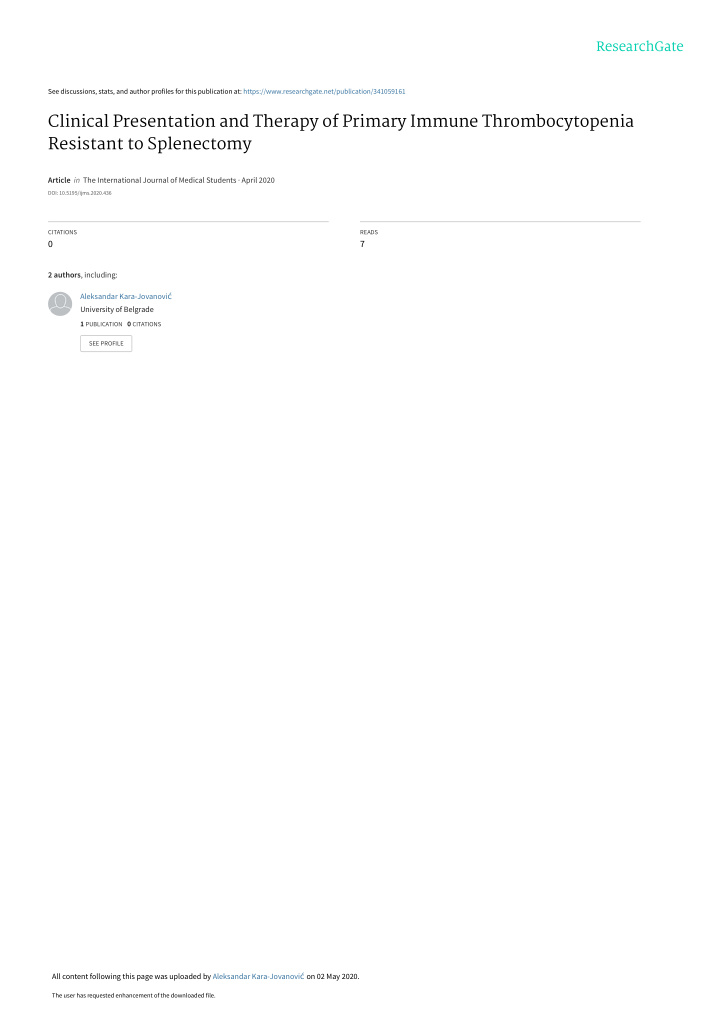



See discussions, stats, and author profiles for this publication at: https://www.researchgate.net/publication/341059161 Clinical Presentation and Therapy of Primary Immune Thrombocytopenia Resistant to Splenectomy Article in The International Journal of Medical Students · April 2020 DOI: 10.5195/ijms.2020.436 CITATIONS READS 0 7 2 authors , including: Aleksandar Kara-Jovanovi ć University of Belgrade 1 PUBLICATION 0 CITATIONS SEE PROFILE All content following this page was uploaded by Aleksandar Kara-Jovanovi ć on 02 May 2020. The user has requested enhancement of the downloaded file.
varying bleeding tendency. The severity of bleeding frequently life. 5 fatigue, infections, hematologic malignancies and reduced quality of thrombotic events in comparison to adults without ITP, as well as newly diagnosed with ITP. 5 Patients with ITP have an increased risk of most worrisome complication of ITP, with an incidence of 6/340 adults common clinical manifestation of ITP. Intracranial hemorrhage is the menorrhagia, gingival and gastrointestinal bleeding) is the most severe thrombocytopenia. 3-4 Mucocutaneous bleeding (epistaxis, patients with ITP do not experience significant bleedings despite having correlates with a low platelet count and older age. However, many The clinical presentation of ITP is most often asymptomatic or with a are ruled out. significant bleeding. 1 splenectomy and that requires treatment to reduce the risk of clinically ITP is defined as a disease that does not respond to or relapses after persistent ITP (3–12 months), and chronic ITP (>12 months). Refractory included division by disease phase: newly diagnosed ITP (<3 months), classification criteria, and outcome measures. The classification scheme International Working Group (IWG) presented standards for definitions, per year with a prevalence of 9.5 per 100 000 adults. 1 In 2009, the bleeding. 1-2 The incidence of primary ITP in adults is 3.3/100 000 adults The diagnosis of ITP is made when all other causes of thrombocytopenia Original Article are no longer removed via the spleen and spleen antiplatelet antibodies in 60% of patients, with 75% of relapses recorded in the first 4 years. long follow-up period. In most published studies, remission is achieved other studies imply that all patients with ITP relapse after a sufficiently splenectomy leads to long-term remission in 60–80% of patients, while efficacy and side-effects are controversial. Particular studies show that the short-term efficacy of splenectomy, findings on its long-term 80% of patients with ITP. 8 Even though there is a consensus regarding induced remission. 1,6,8-9 Good therapeutic response is achieved in 60– for 6–12 months, considering a possible spontaneous or therapeutically are no longer produced. Splenectomy should be postponed, if possible, corticosteroids. By performing splenectomy, antibody-coated platelets The therapy objectives are to achieve a safe number of platelets (often Splenectomy is reserved for patients unresponsive to or intolerant to thrombocyte count ( Table 1 ). 6-7 <30x10 9 /L, or when bleeding symptoms present in spite of a high the platelet count. Treatment should begin when the platelet count is procedures), comorbidities, individual side effect tolerance, as well as risk factors (such as anticoagulant therapy, dialysis, surgical according to the clinical presentation, presence of additional bleeding and to sustain a normal quality of life. 1 The therapy should be tailored >30x10 9 /L), to avoid life-threatening bleeding and long-term treatment, absence of evident predisposing factors, and by an increased risk of acquired disease of adults and children characterized by a transient or Immune thrombocytopenic purpura (ITP) is an immune-mediated Aleksandar Kara-Jovanović Int J Med Students • 2020 | Jan-Apr | Vol 8 | Issue 1 Process: Peer-reviewed Publication: Apr 30, 2020 Acceptance: Dec 28, 2019 Submission: Dec 10, 2019 Student Editors: David Avelar Rodriguez Email: aleksandar.karajovanovic@gmail.com Address: 8 Dr Subotića Street, Belgrade, Serbia. Correspondence: academic studies. He is currently working on a research paper concerning thrombotic events in acute myeloid leukemia. 2 Clinic of Hematology, Clinical Center of Serbia in Belgrade, Serbia. 1 Medical Faculty, University in Belgrade, Belgrade, Serbia. DOI 10.5195/ijms.2020.436 | ijms.info 11 Clinical Presentation and Therapy of Primary Immune Thrombocytopenia Resistant to Splenectomy Introduction (Source: MeSH-NLM). Key Words: Immune thrombocytopenia; Idiopathic thrombocytopenic purpura; Refractory immune thrombocytopenia, Thrombopoietin receptor agonists ITP patients. splenectomy-resistant patients achieving remission. Thrombopoietin receptor agonists have shown exceptional results so far in the treatment of refractory patients, respectively. Conclusion: Splenectomy remains a very efficient therapeutic modality for the treatment of ITP patients with a high percentage of danazol (50%) and corticosteroids (40.9%). Hemorrhagic and non-hemorrhagic complications occurred in 78.6% (n=22/28) and 28.6% (n=8/28) of the response was usually achieved using the following drugs: romiplostim (100%), eltrombopag (75%), cyclosporine (66.67%), mycophenolate mofetil (50%), to splenectomy, 67.8% (n=19/28) showed a good therapeutic response: 49% (n=14/28) complete remission and 18.8% (n=5/28) partial remission. The 117 months (range 3-474). The average follow-up period of the patients resistant to splenectomy was 147 months (range 23-474). Of the patients refractory refractory to splenectomy, 11.6% (n=16/138) relapsed and 8.7% (n=12/138) were primarily resistant. The average post-splenectomy follow-up period was Hematology, Clinical Center of Serbia, and who underwent splenectomy between 1987 and 2018. Results: Of the 138 ITP patients, 20.3% (n=28/138) were splenectomy-resistant ITP. Methods: We retrospectively analyzed 138 adult ITP patients who had been previously diagnosed and treated at the Clinic of establish the frequency of resistance and relapse after splenectomy, the occurrence of complications, the therapeutic strategies and the drug efficacy in (ITP). There is an ongoing consensus on the short-term efficacy of splenectomy, however, its long-term efficacy remains controversial. Our aim was to Background: A satisfactory therapeutic response is achieved with splenectomy in 60–80% of the patients diagnosed with immune thrombocytopenic purpura Abstract The response was achieved in 83% of patients who needed further Aleksandar Kara-Jovanovi ć , 1 Nada Suvajd ž i ć -Vukovi ć. 2 persistent decrease of the platelet count below 100 × 10 9 /L in the About the Author: Aleksandar Kara-Jovanovi ć is currently a 6th-year medical student in the Faculty of Medicine at the University of Belgrade, Serbia within the six-year integrated Editor: Mihnea-Alexandru G ă man T he I nternational J ournal of M edical S tudents
Recommend
More recommend